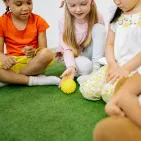
The story of Michael
Michael’s 4th grade teacher had reached out to his parents, John and Marie, to explain that he had been struggling in class. Michael had been a strong learner in previous school years, but this year things seemed different. He needed more help than usual to understand instructions, and he wasn’t as excited as he used to be to play with his friends during recess.
After ruling out the possibility of learning challenges, or any underlying problems with his friends, John and Marie reached out to a parent peer support worker to help them explore what might be going on. Through this conversation, they shared that things had changed at home recently. John had taken on new responsibilities at work that caused him to work occasional weekends, when he would’ve usually taken Michael to a local baseball game. Marie had always worked part-time when Michael started school, but recently began working full-time and was getting home later in the evenings. While previously she would have picked him up from school, Michael’s grandmother had now taken this over, and would stay with him until John or Marie got home.
John and Marie realized that these big changes might be impacting Michael in ways they hadn’t realized. The parent peer support worker mentioned Michael’s behavior might be his way of communicating to his parents that he needed something and didn’t know how to express it. As a result, they encouraged John and Marie to try to understand Michael’s love language as one way to help understand his recent change in behaviour.
What are love languages?
A love language is how a person shows that they love someone, and also how they receive affection from others around them (Chapman, 2015).
While the ‘Love Languages’ framework was originally aimed at couples, many of the concepts can be applied to the caregiver-child relationship as well. Understanding your own and your child’s love language can lead to better communication and a stronger connection.
Not everyone’s love language will be the same. Originally developed by Gary Chapman, these love languages have commonly been split up into 5 different categories:
Acts of Service: You appreciate it when someone does something helpful for you, like unloading the dishwasher, or preparing your lunch for the next day.
When your child asks you to do something for them, this might be their way of expressing a need for extra love and attention. Sometimes, repeated requests from your child may feel overwhelming, and even contribute to burnout. It may help to reframe seeing these requests as a desire to connect and feel loved. It can also be helpful to encourage independence and support them with doing things for themselves, as developmentally appropriate. In doing so, the best act of service you can provide your child is guiding them through a new process and teaching them, step-by-step, how to complete it themselves.
Signs that your child may prefer this love language include:
- Requesting help for things they can do themselves (i.e. tie their shoe, make their snack, teach homework they’re familiar with)
- Asking you to fix their broken toy, instead of asking you to buy a new one
Receiving Gifts: You feel loved when someone shows their affection by giving you a thoughtful gift, such as a treat, or a hand drawn picture.
The receiving of gifts can be a powerful way for some children to feel loved. A child, whose primary love language is receiving gifts, will be happy with the smallest item, or even something handmade.
Signs that your child may prefer this love language include:
- Preferring to keep everything they have been given, even if they don’t use/play with it
- A child who highly values items that they have received from you
Quality Time: You feel loved when someone gives you their undivided attention, whether through conversation or doing an activity together.
When you are with your child, being fully present shows them that they are important and you enjoy spending time with them. What you do with your child is less important than the actual time you spend together.
Signs that your child may prefer this love language include:
- A child who often says “Watch this!” or “Play with me!”
- A child who is always wanting to come along on errands
Words of Affirmation: You feel loved when someone expresses their appreciation for you verbally, or in a text or letter.
Words are a powerful tool to communicate love. In fact, they have the potential to nurture a child’s sense of self worth and security as they grow.
When interacting with your child, it is important to be mindful of the type of words you use. Harsh and critical words can have a negative effect on all children, but particularly those whose primary love language is words of affirmation.
Signs that your child may prefer this love language include:
- Them beaming whenever you praise them
- Them offering you lots of sweet feedback
- Them continuously seeking compliments
Physical Touch: You feel loved when you share physical touch with someone, for example, with a hug, holding hands, or sitting close together.
To a child whose primary love language is physical touch, the physical connection communicates love and care to them more deeply than if you were to praise them, give them gifts, or do acts of service for them. Acts of physical touch can foster a sense of security and belonging in your relationship with them. .
Signs that your child may prefer this love language include:
- Constantly being in your space, touching you, or playing with your hair
- They love hugging, cuddling, high fives and back scratches
Fun Fact: The average length of a hug between two people is 3 seconds. But some research has found that a hug that lasts for longer, such as 20 seconds, has a therapeutic effect on the body and mind due to the production of the hormone oxytocin which affects our physical and mental health (Grewen, K.M., et al. 2003). This hormone release creates a strong bond and connection between the huggers, thereby helping us to feel more relaxed and calm.
How do I know what my child’s love language is?
Some parents might struggle with knowing how best to convey their love for their child. Some ways you can help identify your child’s love language(s) are:
Observe your child: Get really curious about them and watch how they express and receive love from you and others
- Do they ask for a hug every morning, and want to sit in your lap for story time each night? If so, physical touch could be their love language.
- If they always seem to be helping others complete their chores, such as cleaning up the play room, acts of service may be their primary love language.
- Use process of elimination: observe things they might shy away from (e.g., hugs)
Look for patterns: Give children choices and see if you can find a pattern based on what they choose.
- For example, if your child wins a spelling-bee competition, let them pick between a new toy or a special lunch with just the two of you. What they choose could be telling of the type of love language they prefer.
Understand if your child has special needs: Children with special needs, such as autism and sensory issues, may express and receive love differently than other children. It’s important to remember that all children need, crave and show love in different ways.
Remember to not be too hard on yourself if you’re having trouble decoding your child’s love language. The way a child prefers to show and receive affection isn’t always clear at first but through time and observation, it will begin to become more evident.
Love Languages in Action
Once you’ve landed on your child’s love language, you can start to think about different ways to express your love in meaningful ways for them. Here are some examples to help you get started:
Acts of Service:
- Bringing them breakfast in bed or their favourite snack
- Helping them clean a big mess
- Offering/sitting down to help them with their homework
Receiving Gifts:
- Making or buying them something small, inexpensive and thoughtful.
- Choose gifts that fit their interests.
- Adding to their collection of…(rocks, trading cards, stickers)
Quality Time:
- Think about hobbies or interests you both enjoy and can spend quality time together doing
- Taking walks together and having conversations
- Showing up for their class parties, performances, and sporting events
Words of Affirmation:
- Telling them something specific you love about them every day
- Starting a journal where you can write positive messages and love notes back and forth
- Working through any mistakes your child makes, acknowledging their good intentions and effort, and using encouraging words and phrases
Physical Touch:
- Offering to hold hands on a walk
- Making up a secret handshakes
Conclusion
After speaking with the parent peer support worker, John and Marie spent some time thinking about what Michael’s love language might be. They realized that Michael thrived when they gave him more quality time. Given how their schedules had changed at home, they recognized that Michael’s behaviour changes might have been his way of communicating that he was missing that special time with them.
Sometimes, children may show challenging behaviours like Michael, because their need for love is not being met. By learning to give love in ways our child can best understand, you can prevent challenging behaviour, create stronger relationships and connect more deeply with your child.
“In order to know how to best respond, it’s important to figure out what’s driving your child’s behaviour” says Dr. Janet Mah in the Where You Are podcast on Tantrums, outburst and negotiations: Parenting kids with challenging behaviours. In Michael’s case, he was needing more quality time with his parents to feel loved and didn’t know how else to ask for it except by exhibiting challenging behaviour. As such, John and Marie began setting aside time in their schedules to spend time with Michael, and letting him know ahead of time when things might be a bit more busy.
At a follow up with the parent peer support worker, John and Marie mentioned that they noticed improvements in Michael’s behaviour, and that things were getting better at school and with his friends. They had learned to speak their son’s love language, and say “I love you” in a way that Michael could understand.
Disclaimer: The narrative in this blog is a work of fiction. Any names or characters, businesses or places, events or incidents, are fictitious.







